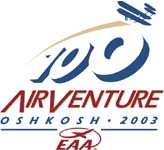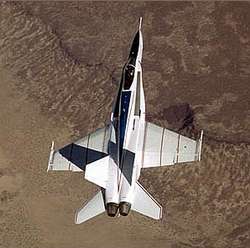Mon, Jun 09, 2003
First Public Demonstration Of NASA's Aeroelastic Wing
 A supersonic F/A-18 fighter jet that has a new
twist - literally - courtesy of NASA will make its first appearance
on the EAA AirVenture Oshkosh flight line this summer, during the
Experimental Aircraft Association’s 51st annual convention,
July 29-August 4 at Wittman Regional Airport at Oshkosh (WI). The
Active Aeroelastic Wing (AAW) flight research aircraft completed
its first phase of test flights in early May. Over the 50 test
missions held since last November, the F/A-18 was flown to
determine its handling with specially modified flexible wings. The
wings have thinner covering “skins” along with other
technical enhancements that allow the outer wing panels to twist up
to five degrees. The concept could allow lighter-weight wings to
supply better maneuverability for future high-performance military
aircraft.
A supersonic F/A-18 fighter jet that has a new
twist - literally - courtesy of NASA will make its first appearance
on the EAA AirVenture Oshkosh flight line this summer, during the
Experimental Aircraft Association’s 51st annual convention,
July 29-August 4 at Wittman Regional Airport at Oshkosh (WI). The
Active Aeroelastic Wing (AAW) flight research aircraft completed
its first phase of test flights in early May. Over the 50 test
missions held since last November, the F/A-18 was flown to
determine its handling with specially modified flexible wings. The
wings have thinner covering “skins” along with other
technical enhancements that allow the outer wing panels to twist up
to five degrees. The concept could allow lighter-weight wings to
supply better maneuverability for future high-performance military
aircraft.
In The Spirit Of Oshkosh
“This airplane is a perfect complement to EAA’s
flight centennial celebration at Oshkosh this year,” said Tom
Poberezny, EAA President and AirVenture Chairman. “The idea
of reshaping a wing in flight has been with us since the beginning
of powered flight. NASA, however, is using the concept to create
the innovations that will greet us as we move into aviation’s
second century.”
 The flexible-wing idea actually harkens back to
the first successful powered flight by the Wright brothers in 1903.
The Wrights were able to make their successful flights after
mastering a concept called “wing warping,” where the
wing’s shape could be slightly altered in flight to provide
the pilot more control. Unlike the Wrights, who had to mechanically
twist the wingtips on their “Flyer,” the F/A-18 test
aircraft relies on control surfaces such as ailerons and flaps to
twist the wings.
The flexible-wing idea actually harkens back to
the first successful powered flight by the Wright brothers in 1903.
The Wrights were able to make their successful flights after
mastering a concept called “wing warping,” where the
wing’s shape could be slightly altered in flight to provide
the pilot more control. Unlike the Wrights, who had to mechanically
twist the wingtips on their “Flyer,” the F/A-18 test
aircraft relies on control surfaces such as ailerons and flaps to
twist the wings.
The F/A-18, used by the Navy and Marine Corps, is a front-line
fighter that can operate from both land bases and aircraft
carriers. They are perhaps best known as the aircraft flown by the
navy’s renowned “Blue Angels” flight
demonstration team.
When the airplane was first built in the early 1980s, the wings
were too flexible to meet military specifications. The wings were
stiffened to meet the aerial maneuvering demands for the military,
but the potential of flexible wings was retained for additional
research. That research and test flight programs are being
conducted at NASA’s Dryden Flight Research Center in Edwards
(CA)
NASA’s AAW F/A-18 will be on display throughout EAA
AirVenture on the event’s AeroShell Square showcase ramp.
More News
Pilot Also Reported That Due To A Fuel Leak, The Auxiliary Fuel Tanks Were Not Used On June 4, 2025, at 13:41 eastern daylight time, a Piper PA-23, N2109P, was substantially damage>[...]
From 2023 (YouTube Edition): Reflections on War’s Collective Lessons and Cyclical Nature The exigencies of war ought be colorblind. Inane social-constructs the likes of racis>[...]
Pilot Reported That He Was Unfamiliar With The Single Seat Amateur-Built Airplane And His Intent Was To Perform High-Speed Taxi Testing Analysis: The pilot reported that he was unf>[...]
From 2023 (YouTube Edition): First Kits to Ship October 2023 Having formerly resurrected the storied shape of the Ryan ST—in effigy, anyway—Montrose, Colorado-based Tim>[...]
Performance-Based Navigation (PBN) [ICAO] Area navigation based on performance requirements for aircraft operating along an ATS route, on an instrument approach procedure or in a d>[...]
 NTSB Prelim: Piper PA-23
NTSB Prelim: Piper PA-23 Classic Aero-TV: One Mans Vietnam
Classic Aero-TV: One Mans Vietnam NTSB Final Report: Capella Aircraft Corp FW1C50
NTSB Final Report: Capella Aircraft Corp FW1C50 Classic Aero-TV: Timber Tiger Touts Curtiss Jenny Replicas
Classic Aero-TV: Timber Tiger Touts Curtiss Jenny Replicas ANN's Daily Aero-Term (07.04.25): Performance-Based Navigation (PBN) [ICAO]
ANN's Daily Aero-Term (07.04.25): Performance-Based Navigation (PBN) [ICAO]




